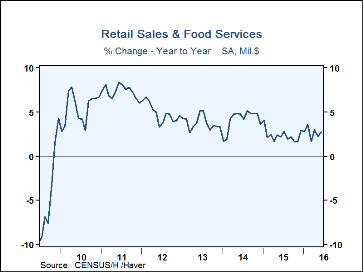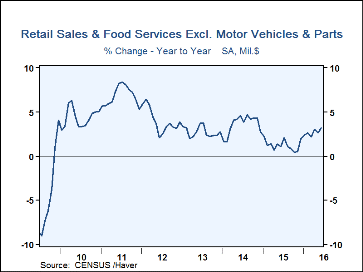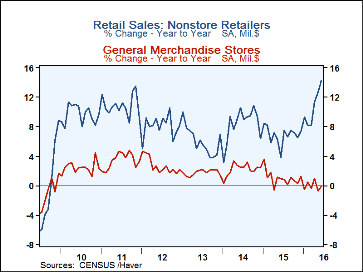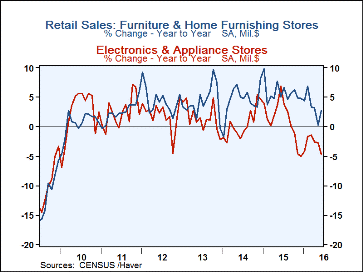 Global| Jul 15 2016
Global| Jul 15 2016U.S. Retail Spending Posts Firm Increase
by:Tom Moeller
|in:Economy in Brief
Summary
Total retail sales & spending at restaurants increased 0.6% during June (2.7% y/y) following a 0.2% May gain, revised from 0.5%. The rise compared to expectations for 0.1% growth in the Action Economics Forecast Survey. Healthy [...]
Total retail sales & spending at restaurants increased 0.6% during June (2.7% y/y) following a 0.2% May gain, revised from 0.5%. The rise compared to expectations for 0.1% growth in the Action Economics Forecast Survey.
Healthy increases in sales were broad-based. Overall retail sales excluding autos gained 0.7% (3.2% y/y). A 0.4% rise had been expected. Sales in the retail control group, which also excludes gasoline, building supplies and food services, rose a steady 0.5% (4.1% y/y). This figure is used in the computation of the GDP.
Retail sales increased 0.7% (2.4% y/y) following a 0.2% rise. The gain was lifted by a 1.2% rise in gasoline service station sales with higher prices. Motor vehicle & parts sales improved 0.1% (1.0% y/y) after a 0.5% decline. That compares to a 4.5% decline in unit vehicle sales. Retail sales excluding motor vehicles jumped 0.9% (2.9% y/y) after a 0.4% increase.
Building material & garden equipment sales surged 3.9% (7.6% y/y) and made up declines during the prior three months. Sales at nonstore retailers firmed 1.1% (14.2% y/y), the fifth month this year of outsized increases. Sporting goods store sales increased 0.8% (6.8% y/y) after a 1.3% jump. Sales at furniture & home furnishing stores increased 0.5% (2.7% y/y) following a 0.1% easing. General merchandise store sales improved 0.4% (-0.2% y/y) and made up the prior month's fall. On the weak side, clothing store sales declined 1.0% (-0.9% y/y) and reversed the May increase. Restaurant sales eased 0.3% (+4.9% y/y) after a 0.5% gain. Electronics & appliance store sales remained unchanged (-4.7% y/y) following a 0.4% gain.
In the non-discretionary spending categories, health & personal store sales improved 0.7% (8.4% y/y) following a 0.6% rise while food & beverage store sales gained 0.5% (2.7% y/y) after a 0.4% rise.
The retail sales figures are available in Haver's USECON database. The Action Economics figures are in the AS1REPNA database.
| Retail Spending (%) | Jun | May | Apr | Jun Y/Y | 2015 | 2014 | 2013 |
|---|---|---|---|---|---|---|---|
| Total Retail Sales & Food Services | 0.6 | 0.2 | 1.2 | 2.7 | 2.3 | 4.1 | 3.8 |
| Excluding Autos | 0.7 | 0.4 | 0.9 | 3.2 | 1.2 | 3.6 | 2.7 |
| Non-Auto Less Gasoline, Building Supplies & Food Services (Control Group) | 0.5 | 0.5 | 1.1 | 4.1 | 3.3 | 4.0 | 2.9 |
| Retail Sales | 0.7 | 0.2 | 1.4 | 2.4 | 1.6 | 3.9 | 3.8 |
| Motor Vehicle & Parts | 0.1 | -0.5 | 2.6 | 1.0 | 6.5 | 6.4 | 8.3 |
| Retail Less Autos | 0.9 | 0.4 | 1.0 | 2.9 | 0.2 | 3.2 | 2.6 |
| Gasoline Stations | 1.2 | 2.2 | 2.7 | -9.6 | -19.4 | -2.4 | -1.2 |
| Food Service & Drinking Places Sales | -0.3 | 0.5 | 0.2 | 4.9 | 8.0 | 6.1 | 3.7 |
Tom Moeller
AuthorMore in Author Profile »Prior to joining Haver Analytics in 2000, Mr. Moeller worked as the Economist at Chancellor Capital Management from 1985 to 1999. There, he developed comprehensive economic forecasts and interpreted economic data for equity and fixed income portfolio managers. Also at Chancellor, Mr. Moeller worked as an equity analyst and was responsible for researching and rating companies in the economically sensitive automobile and housing industries for investment in Chancellor’s equity portfolio. Prior to joining Chancellor, Mr. Moeller was an Economist at Citibank from 1979 to 1984. He also analyzed pricing behavior in the metals industry for the Council on Wage and Price Stability in Washington, D.C. In 1999, Mr. Moeller received the award for most accurate forecast from the Forecasters' Club of New York. From 1990 to 1992 he was President of the New York Association for Business Economists. Mr. Moeller earned an M.B.A. in Finance from Fordham University, where he graduated in 1987. He holds a Bachelor of Arts in Economics from George Washington University.










